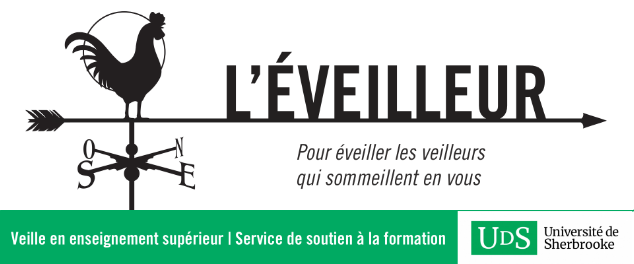La critique du cours magistral n’est pas nouvelle, mais elle m’apparaît prendre encore de la vigueur. Par exemple, ces commentaires de Sol Kauffman, un étudiant en rédaction de l’Université de Victoria dans le Macleans – Student Issue :
« Now in my third year, this bizarre experience has stayed with me: how I skipped almost every class and still got an A, how the university made some poor professor stand up there to be ignored for four months, and what that says about lecture courses. »
L’auteur s’insurge ensuite contre deux nouvelles politiques de son université concernant le renvoi après deux cours manqués et l’interdition des portables en classe autrement que pour la prise de notes.
«Students will take diligent notes if the material is worth taking notes on, and the more universities engage students, the less they have to deal with disrespect and absenteeism. But the policy change is consistent with other Canadian universities. They are treating the symptoms while ignoring the disease: lectures that aren’t worth attending. » [nos emphases]
Kauffman s’interroge sur l’impregnation des connaissances acquises par les cours magistraux et souhaite par ailleurs que l’université lui donne l’occasion de développer de véritables compétences.
« …[T]he concept of teaching something verbally, having students take notes, memorize material and then pass tests on it is simply outdated. For one thing, students become extremely good at managing their time and cramming to pass tests. This reduces the amount of information you retain; I hardly remember anything of the economics class. More importantly, I can always refresh my economics knowledge online. What I don’t have is the ability to assess a situation and make an economic judgment, because that requires skills. I don’t want my university experience to be a simple rite of passage where I have to prove I can memorize things long enough to prove I did. That’s a waste of everyone’s time and money. » [nos emphases] […]
« We have to demand that universities prepare us for the modern job market. My writing workshops are a good example. Each class requires you to show up with comprehensive edits for your classmates’ pieces, and several times a term you have to submit your own drafts for group revision. Class discussions are lively and involved. The work we do is what we’d do in the field. It’s the same for my photography and journalism classes now that I’m in fourth year. » […]
« Let’s go beyond brainstorming stuff with your seatmate for five minutes and get into creating and critiquing each others’ professional-grade work. Now that I would love to shell out for. »
Cet étudiant semble clairement souhaiter être plus actif dans son apprentissage. En parallèle, deux articles suggérés par Francheska. L’un du Harvard Magazine à propos des méthodes actives qui s’intitule « Twilight of the Lecture » [litéralement le « Crépuscule du cours magistral »]. On y présente notamment la méthode « Peer Instruction » d’Eric Mazur (dont nous avons parlé à plusieurs reprises) et où ce dernier a des commentaires cinglants quant à l’enseignement magistral traditionnel :
« [Mazur] asserts that he is “far more interested in learning than teaching,” and envisions a shift from “teaching” to “helping students learn.” The focus moves away from the lectern and toward the physical and imaginative activity of each student in class. » […]
« The active-learning approach challenges lecturers to re-evaluate what they can accomplish during class that offers the greatest value for students. Mazur cites a quip to the effect that lectures are a way of transferring the instructor’s lecture notes to students’ notebooks without passing through the brains of either. (He also likes a quote from Albert Camus: “Some people talk in their sleep. Lecturers talk while other people sleep.”) “The danger with lucid lectures—of which we have so many on this campus, with so many brilliant people—is that they create the illusion of teaching for teachers, and the illusion of learning for learners,” he says. “Sitting passively and taking notes is just not a way of learning. Yet lectures are 99 percent of how we teach!” [notre emphase]
Enfin, un billet de Robert Talbert son blogue Casting Out Nines où le professeur de mathématiques remet en question l’idée répandue à l’effet qu’avec les méthodes actives, les étudiants apprendraient par eux-mêmes. Selon lui, les méthodes actives transmettent autant de contenu, mais à l’extérieur de la classe. Les problèmes travaillés en classe permettent d’ancrer les savoirs et le formateur peut d’autant soutenir les apprentissages :
« To my way of thinking, it’s in the traditional classroom where students are teaching themselves, because the real learning comes from assimilation — not receiving information, but internalizing it through working on problems. And in the traditional classroom, I am given this work to do on my own. I may have the option to work in groups or come to office hours, but that’s not the default. It may not even be an option. »
Sources :
Kauffman, Sol, « Stop Lecturing Students », Macleans On Campus, 15 février 2012.
Lambert, Craig, « Twilight of the Lecture », Harvard Magazine, Mars-Avril 2012
Talbert, Robert, « When are students teaching themselves ? », Casting Out Nines, 17 février 2012







Si ces critiques soulèvent en effet des problèmes importants, le choix de « vendre » une formule pédagogique en mettant de l’avant les faiblesses d’une autre me semble hautement discutable. Comme si le problème ne résidait pas plutôt dans l’adéquation entre ce que l’on veut développer chez les étudiants et les moyens qu’on prend pour y arriver. L’apprentissage actif est certainement riche, mais présente aussi ses limites.
Je signale donc un autre point de vue sur la même question, de la part d’un commentateur de longue date que j’apprécie pour son sens critique et son point de vue éclairé sur l’enseignement supérieur. Je le précise pour ne pas donner l’impression d’une réaction défensive de la part d’un professeur ancré dans ses habitudes (et ses vieilles notes de cours) qui se sentirait menacé 😉
« Even if students are not used to sitting and listening (God forbid!) to someone else talking for more than a few minutes, the capacity to pay attention to others who have something important to say is an ability worth developing.
Okay, fine, but aren’t lectures boring? No, bad lectures are boring, but that’s no reason to condemn lecturing as a whole, any more than a bad song is a reason to condemn music. (…) Still, we keep hearing that lectures are passive and learning these days should be active. Here again, good lectures are not simply the passive transfer of information. Good lectures can be interactive (depending on class size) and (regardless of class size) can always be engaging. Listening and thinking hard about what is being said is not “passive” in the intellectual sense, and the intellectual sense if what counts. » [mes emphases]
Todd Pettigrew, “Why traditional lectures will thrive”, Macleans on campus, 19 janvier 2012. http://oncampus.macleans.ca/education/2012/01/19/why-traditional-lectures-will-thrive/
Un peu comme Catherine, je me réjouis qu’un mouvement important émerge pour de meilleures approches pédagogiques universitaires, tout en ayant le souci de ne pas jeter le bébé avec l’eau du bain.
Le commentaire de l’auteur cité par Catherine va dans le même sens que celui du professeur Richard Mayer que j’ai cité dans un billet précédent : il ne faut pas confondre activité comportementale et activité cognitive. On peut très bien être très actif cognitivement, même si on ne l’est pas comportementalement. L’exposé magistral comme partie d’une stratégie d’enseignement plus globale peut être un excellent outil.
Le problème est que l’on observe énormément de cas où l’exposé magistral est mal utilisé ou n’est pas combiné avec d’autres méthodes qui viennent le compléter. Rehausser et compléter l’exposé magistral (et possiblement l’alléger) dans une stratégie globale d’apprentissage actif semble être une voie prometteuse.